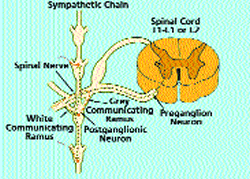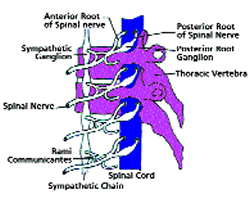Positive Health Online
Your Country

The Relevance of the Sympathetic Nervous System
listed in anatomy and physiology, originally published in issue 142 - December 2007
Your heart is beating faster and harder, your breathing is more forceful, your mouth is dry and your eyes are somehow wider, pupils dilated, taking in as much information as possible… Your face and skin may be a little flushed and your muscles are ready and tingling for action… You may be feeling nervous in your stomach, scared, or even excited about what is going on in this instant… Whatever it is, you have the nerve fibres of the sympathetic nervous system to thank for this range of reactions that is preparing you for a lot of action. 

How does this range of nerves get around the body? The pathways may not turn out to be exactly what you first imagine, as their distribution is a little unusual (well I think so anyway!).
All of the individual nerve fibres that cause the range of reactions that we label the ‘sympathetic nervous system’ exit the spinal cord only between T1 and L2, none of them exit the brain via cranial nerves or exit the spinal cord above T1 or below L2. Yet we know that they are having an effect in the face, on the pupil, and on blood vessels and skin all over the body. So how do they get to the upper and lower reaches of the body?
First of all, as these fibres exit with other nerve fibres from the spinal cord – the spinal nerve from any of T1 to L2 – all the sympathetic fibres within each spinal nerve take an almost immediate side route towards a ‘sympathetic ganglion’. This side route is called the white rami communicantes – due to the fact that the nerve fibres are myelinated. It is a bit like coming off the motorway to a service station...
Once in the ganglion, one of three things can happen:
1. The nerve can synapse here and then return to the spinal nerve it came from, hitching a ride to wherever it is going – this is usually muscles, skin or near blood vessels. So this is where we might find the fibres that innervate sweat glands to help us sweat and release heat, or help the blood supply to muscles dilate so more blood goes to and from them. The slip road back onto the motorway is called the grey rami communicantes as the nerves are non-myelinated.
But not all the fibres do this…
2. Some turn a corner in the ganglion to go up to a higher, or down to lower, ganglia via the ‘sympathetic chain’ through which all the ganglia are linked. This sympathetic chain is part of the way that the fibres get above and below T1 and L2. It sits on the lateral sides of the vertebral bodies, and is clearly visible in cadavers, each rounded ganglia linked above and below by a thinner nerve tract.There are three ganglia above T1, called the superior, middle and inferior cervical ganglia. A variety of nerve fibres travel up to synapse in each before heading off towards some of our upper structures.
The uppermost one, the superior cervical plexus, sits next to the internal carotid artery and takes advantage of this to piggyback with it into the cranial cavity via the carotid canal. Once inside the cranium it travels to the eye, ready when required to contract the muscles that dilate the pupil. Other fibres nestle in with the external carotid to reach other blood supplies of the face and structures, including the salivary and lachrymal glands and some of the mucosa of the nasal cavity.
The ganglia lateral to each side of L2 are the last to receive the fibres directly from the spinal cord; below this there are usually another two lumbar ganglion and four sacral, before the two sides of the chain come together in the ganglion impar, anterior to the coccyx.
Interestingly, from the lower ganglion, we still have fibres that hop into the spinal nerves from L2-S4 – and since they are still un-myelinated they are still called grey rami communicantes. Here we need to have sympathetic fibres helping us to excrete waste products via the colon and bladder, as well as experience the physical states of sexual arousal. (Interestingly, the orgasmic and ejaculatory part is instigated by the parasympathetic nervous system).
From its spot inside one of the ganglia of the sympathetic chain the third thing a fibre may do is:
3. From the ganglia in which they synapse they can then head directly towards an organ, where they have names like greater, lesser and least splanchnic, lumbar splanchnic or cardiac/pulmonary sympathetic. The nerves carrying theses fibres often synapse or pass through a plexi before they get to the organ, so that they can interlace with parasympathetic fibres and all travel together (often with some sensory or afferents coming back via this system). The main plexi are the cardiac and pulmonary (heart and lungs), coeliac (solar plexus area), superior and inferior mesenteric (intestines) and superior and inferior hypogastric plexi (going to the pelvis).There are bodywork techniques that work gently and directly with these plexi, to assist in unwinding and resetting the firing pattern if necessary... never have I experienced so fast and deep a sense of relaxation! Yet anytime we experience the sense of relaxation after a treatment it is because we have helped the client turn down their sympathetic nervous system (and our own perhaps!), and by default, enhanced the parasympathetic nervous system (clue: the stomach gurgles, etc!)
Since the sympathetic and parasympathetic systems do work together and complement each other, we will look at the anatomy of the latter next time round and compare physiology and function after that.
Comments:
-
No Article Comments available